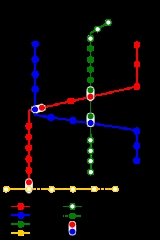
Tashkent Metro
Encyclopedia
The Tashkent Metro is the rapid transit system serving the city of Tashkent
, the capital of Uzbekistan
. It is the only currently operating subway system in Central Asia
. It was the seventh metro to be built in the former USSR, opening in 1977. Its stations are among the most ornate in the world.
struck the city in 1966. Construction on the first line began in 1972 and it opened on November 6, 1977 with nine stations. This line was extended in 1980, and the second line was added in 1984. The most recent line is the Yunusobod Line, the first section of which opened in 2001. A northern extension of this line is currently under construction, and a fourth line is expected to follow in 2010.
Today, the Tashkent metro has 29 stations that differ from each other. The architecture and décor of each station depicts its name. The peculiarity of the Tashkent metro is its rather shallow station positioning. Some stations have escalators, 7 stations belong to the tower type, 4 stations to the arch type and one station (Mustakillik) to the tower-individual type. Prominent architects and artists of Uzbekistan took part in designing the stations. Interior décor features solid and stable materials: metal (in the form of engravings), glass, plastic, granite, marble, smalt, art ceramics, and carved alabaster. Each station is original work of art and centers on a particular theme.
 Toshkent (Tashkent in Russian), the capital of the former Soviet Republic of Uzbekistan, has more than 2 million inhabitants.
Toshkent (Tashkent in Russian), the capital of the former Soviet Republic of Uzbekistan, has more than 2 million inhabitants.
Chilonzor Line (red): Construction on this line started in 1968, opened in 1977 between Sabir Rakhimov and Oktyabrinkilobi (Russian: Oktyabr'skoy Revolyutsii, now Amir Temur Khiyoboni) including Khamza depot and one metro bridge over Oqtepa channel between Khamza and Komsomolskaya stations. It was extended to Maksim Gor'kiy (now Buyuk Ipak Yoli) in 1980 (including another metro bridge over Salar river between Hamid Alimdzhan and Pushkin stations). It is 16.7 km long with 12 stations - the planned eastward extension to Traktornyi Zavod (3 stations) was under way but now has disappeared from maps.
Uzbekiston Line (blue): The route of this line crosses the city diagonally from northwest to southeast via the Toshkent Railway station. It opened in 1984 and expanded between 1984 and 1991. It is 14.8 km long with 11 stations.
Yunusobod Line (green): Work is under way on this line to connect the northern districts to the airport in the south . The first 7.6 km section with six underground stations opened for regular service on 24 Oct 2001 (test runs began on 28 August 2001 - the 10th anniversary of independence) between Ming Urik (initially planned to be named Lokhutiy) and Habib Abdullayev (initially planned to be named Shahriston). The depth of tunnels varies between 8 and 25 meters. The strong construction of this line can resist earthquakes of a magnitude of 9.0 on the Richter scale. Moscow type 4-car trains are used on 100 m platforms. It sports a 1524 mm gauge and a third rail power supply (825 V DC). The average station distance is 1400 m and trains have a commercial speed of 46 km/h.
Tashkent
Tashkent is the capital of Uzbekistan and of the Tashkent Province. The officially registered population of the city in 2008 was about 2.2 million. Unofficial sources estimate the actual population may be as much as 4.45 million.-Early Islamic History:...
, the capital of Uzbekistan
Uzbekistan
Uzbekistan , officially the Republic of Uzbekistan is a doubly landlocked country in Central Asia and one of the six independent Turkic states. It shares borders with Kazakhstan to the west and to the north, Kyrgyzstan and Tajikistan to the east, and Afghanistan and Turkmenistan to the south....
. It is the only currently operating subway system in Central Asia
Central Asia
Central Asia is a core region of the Asian continent from the Caspian Sea in the west, China in the east, Afghanistan in the south, and Russia in the north...
. It was the seventh metro to be built in the former USSR, opening in 1977. Its stations are among the most ornate in the world.
Lines and stations
| # | Name | Opened | Length | Stations |
|---|---|---|---|---|
| 1 | Chilonzor Line Chilonzor Line The Chilonzor Line was the first line of the Tashkent Metro, opened in 1977 it connected the southern districts of the city with the centre, and then in 1980 extended westwards.-Timeline:-Name changes:-Transfers:... |
1977 | 15.4 km | 12 |
| 2 | Ozbekiston Line Ozbekiston Line The Oʻzbekiston Line is a line of the Tashkent Metro. Built in the 1980s, it connects the northwestern districts of the city with the city centre and then continues eastwards.-Timeline:-Name changes:-Transfers:... |
1984 | 14.8 km | 11 |
| 3 | Yunusobod Line Yunusobod Line The Yunusobod Line is the newest line of the Tashkent Metro, opened in 2001.-Timeline:-Transfers:-Expansion plans:After its opening in 2001 construction began on a northwards extension, however after 2004 all work has been abandoned at 15% completion due to financial difficulties... |
2001 | 6.4 km | 6 |
| 4 | Sirghali Line | Projected | ||
| Total: | 36.2 km | 29 |
History
Planning for the Tashkent Metro started in 1968, two years after a major earthquakeEarthquake
An earthquake is the result of a sudden release of energy in the Earth's crust that creates seismic waves. The seismicity, seismism or seismic activity of an area refers to the frequency, type and size of earthquakes experienced over a period of time...
struck the city in 1966. Construction on the first line began in 1972 and it opened on November 6, 1977 with nine stations. This line was extended in 1980, and the second line was added in 1984. The most recent line is the Yunusobod Line, the first section of which opened in 2001. A northern extension of this line is currently under construction, and a fourth line is expected to follow in 2010.
Today, the Tashkent metro has 29 stations that differ from each other. The architecture and décor of each station depicts its name. The peculiarity of the Tashkent metro is its rather shallow station positioning. Some stations have escalators, 7 stations belong to the tower type, 4 stations to the arch type and one station (Mustakillik) to the tower-individual type. Prominent architects and artists of Uzbekistan took part in designing the stations. Interior décor features solid and stable materials: metal (in the form of engravings), glass, plastic, granite, marble, smalt, art ceramics, and carved alabaster. Each station is original work of art and centers on a particular theme.
System

Chilonzor Line (red): Construction on this line started in 1968, opened in 1977 between Sabir Rakhimov and Oktyabrinkilobi (Russian: Oktyabr'skoy Revolyutsii, now Amir Temur Khiyoboni) including Khamza depot and one metro bridge over Oqtepa channel between Khamza and Komsomolskaya stations. It was extended to Maksim Gor'kiy (now Buyuk Ipak Yoli) in 1980 (including another metro bridge over Salar river between Hamid Alimdzhan and Pushkin stations). It is 16.7 km long with 12 stations - the planned eastward extension to Traktornyi Zavod (3 stations) was under way but now has disappeared from maps.
Uzbekiston Line (blue): The route of this line crosses the city diagonally from northwest to southeast via the Toshkent Railway station. It opened in 1984 and expanded between 1984 and 1991. It is 14.8 km long with 11 stations.
Yunusobod Line (green): Work is under way on this line to connect the northern districts to the airport in the south . The first 7.6 km section with six underground stations opened for regular service on 24 Oct 2001 (test runs began on 28 August 2001 - the 10th anniversary of independence) between Ming Urik (initially planned to be named Lokhutiy) and Habib Abdullayev (initially planned to be named Shahriston). The depth of tunnels varies between 8 and 25 meters. The strong construction of this line can resist earthquakes of a magnitude of 9.0 on the Richter scale. Moscow type 4-car trains are used on 100 m platforms. It sports a 1524 mm gauge and a third rail power supply (825 V DC). The average station distance is 1400 m and trains have a commercial speed of 46 km/h.

